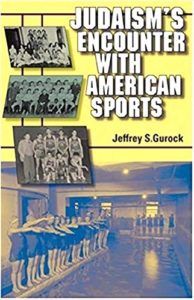JUDAISM’S ENCOUNTER WITH AMERICAN SPORTS, by Jeffrey S. Gurock. Bloomington: Indiana University Press, 2005. Illustrations, Notes, Index. Cloth, $29.95.
The title of this book may inadvertently suggest a broader focus than it actually provides. What it is not is a celebratory account of famous Jewish athletes. Sandy Koufax, Sid Luckman, Hank Greenberg, and a few other notables are barely mentioned.
Jeffrey Gurock, a faculty member at Yeshiva University in New York and a scholar-athlete himself who runs in the New York Marathon and coaches basketball, also pays minimal attention to the question of Jewish athletes participating in sports events that fall on Jewish holidays, whether or not they play for professional teams or high school sports. This has become almost a nonissue in a contemporary America where teams attempt to accommodate the religious faiths of their players in an effort to showcase their awareness of political correctness.
Gurock’s focus here is on how the Jewish faith has met with the challenge presented by sports activities in the United States. That challenge turns out to be extremely complicated and without easy answers. Jewish perception of sports and participation in sports activities depends on whether the Jews are Orthodox, Conservative, or Reform.
Digging deeper, Gurock examines the arguments about sports among Orthodox groups, especially in the yeshivas and day schools, and the leagues in which they play. Add to the mix secular Jews who play on teams organized by Jewish community centers.
The thorniest questions plague Modern Orthodox, Ultra-Orthodox, and other Orthodox factions. And, making the debate even more complicated, there are the generation gap and gender issues.
Jewish girls in American society may be free to choose to be cheerleaders or athletes, but either choice arouses controversy among rabbis and Jewish school administrators and boards of directors. Must girls playing basketball wear sweatpants and long-sleeved shirts or is it all right for them to wear uniforms? May yeshiva boys bring a date to a sports event, and if they do, must they sit in separate sections?
Gurock devotes considerable space to the arguments between Orthodox schools (high schools, yeshivas, and assorted variations and combinations) regarding what are the acceptable rules they can all play by, and the inevitable splintering that create new leagues and boycotts of old ones. Much of this reads like pipul, “unproductive hairsplitting that is employed not so much to advance clarity or reveal meaning as to display one’s own cleverness,” as Leo Rosten defines the word.
Yet there is no doubt that the rabbis and school administrators take the arguments seriously. Judaism’s encounter with the freedom of expression made possible by American sports challenges the centuries when Torah study was paramount in the lives of Jewish students. The opportunity for Jews to take part in sports sent American rabbis scrambling to find and cite biblical justifications for athletes, finding relevance in the deeds of Samson, Moses, and David. The extremes to which the debate may go are shown in the bubble-gum-style trading cards with statistics on prominent rabbis. How many Sean Green cards are worth a Rabbi Aharon Kotler (illustrated on p. 185)?
In concentrating mainly on Jewish schools in the New York-New Jersey area, Gurock’s book neglects how Judaism’s encounter with American sports is taking place in other areas with large Jewish populations, e.g., Los Angeles, Chicago, and other cities. This gives the book a parochialism fast becoming dated in studies of American Jewish history.
Given the wide definitions and many variations in today’s American Jewish community, some readers may wonder what all the fuss is about. It may boil down to the fundamental question of the survival of Judaism in the United States and how one wishes to define survival, whether it be a preservation of traditional Jewish rituals, observances, and rules, or a Judaism that survives through flexibility and adaptation. Judaism’s encounter with sports in America thus becomes a metaphor to define who we are and what we may become.
Abraham Hoffman teaches history at Los Angeles Valley College.

